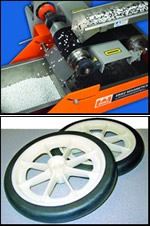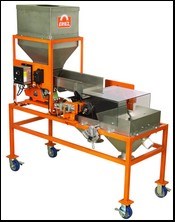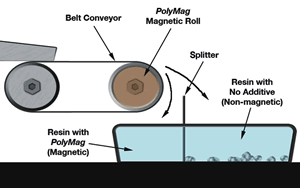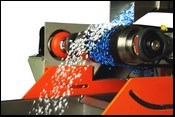Magnetic Separation Simplifies Multi-Material Scrap Recovery
Recent trends to-ward multi-material molding, hard/soft overmolding, and dual-durometer coextrusion create growing volumes of scrap that is difficult or impossible to reuse.
Recent trends to-ward multi-material molding, hard/soft overmolding, and dual-durometer coextrusion create growing volumes of scrap that is difficult or impossible to reuse. Discarding such waste is unattractive with today’s high materials prices and tight supplies of some popular resins. Now there’s a relatively simple and economical way to separate mixed plastics for reuse. It involves using an additive in one component of the mixture that makes it susceptible to magnetic separation.
Eriez Magnetics developed its PolyMag process in 2004 and received a patent in April 2005, but it has just now begun to actively market this technology. It will be featured next month at the NPE show in Chicago. (Eriez’s booths are 1396 and 11205.)
Magnetic separation is a well-established technique used for high-volume separation in the mining, aggregate, and other industries. It is also widely used to remove metal contaminants from plastics but not to separate plastics from each other. Unlike complex float/sink gravity separation systems for mixed plastics, magnetic separation is relative simple and economical and requires little space. It also can separate resins of similar or identical density.
Magnetic separation provides hands-off automation and high reliability in contrast to hazardous, laborious, and inefficient manual methods of cutting apart material components with a knife or band saw. Such methods often result in incomplete separation, so recovered material is usable mainly in lower-value applications. PolyMag is designed to produce high-purity reclaim for high-value parts.
PolyMag technology, which consists of a magnetic additive and conveyor/separator, is aimed initially at processors who utilize multi-material injection molding, overmolding, profile coextrusion, and dual-durometer sequential blow molding. Typical uses would involve separating TPEs from polypropylene and other rigid resins.
This technology is available from Eriez Magnetics’ new PolyMag Div. (booth 11205 at NPE). The first commercial installation is starting up at an automotive molder, which seeks to separate a TPV flexible edge seal from PP in a two-shot molded part. Eriez recently authorized the ACS Group companies—AEC, Colortronic North America, Cumberland Engineering, and Sterling—to market the PolyMag additive and separator equipment as a complement to their own size-reduction systems. ACS Group companies will feature the process at NPE (AEC at booth 1802, Cumberland at 2642, and Sterling at 1849).
Low-dosage additive
Says Eriez president and CEO Tim Shuttleworth, “The magnetic additive approach has been attempted in the past by other companies with no commercial success. Our understanding is that it required the use of a magnetic additive at around 10% concentration, which substantially changes the resin’s physical properties. Our patent covers the use of the additive at a very low dosage—typically 1%. It is the intensity of our PolyMag rare-earth separator that allows this low additive dosage.”
Material supplier Advanced Elastomer Systems (now the Santoprene Specialty Products unit of ExxonMobil) in Akron, Ohio, tested the additive in its Santoprene TPVs. The tests showed no significant effect on physical properties or overmolding adhesion.
PolyMag additive, available in granules and pellets, is a concentrate with a wax-like, FDA-compliant carrier said to be compatible with a wide range of thermoplastics and thermosets. The standard grade contains black iron oxide and is priced in the $4 to $6/lb range. A second grade contains a special magnetic stainless-steel powder, which is suitable for lighter colored applications. It sells for $5.50 to $7.50/lb.
Schematic of PolyMag separation process shows the Kevlar belt conveyor, rare-earth magnetic roll, and splitter that helps segregate the discharge of magnetic and non-magnetic resins into two hoppers.
To minimize cost, the magnetic additive is typically added to the more expensive resin in a multi-material part, such as a TPE, which is often the minority component. PolyMag is usually introduced with an additive feeder mounted below the hopper magnet.
Says John Collins, manager of the PolyMag Div., “More than one plastic in a part can be separated in this way. Plastics containing different amounts of additive will have varying degrees of magnetic susceptibility. Given an appropriate magnetic field and gradient, separation can be achieved through the difference in magnetic susceptibilities.”
How separation works
The PolyMag process is designed to utilize granulated scrap. If there is a chemical bond between different plastics in a part, some regrind particles are apt to contain both components. Some of those particles will end up in one or both separated fractions. Those commingled particles can be separated in a second pass, but Collins recommends instead grinding the scrap more finely to ensure fewer commingled particles.
PolyMag hardware consists of a feed hopper with a stainless-steel vibratory feeder to deliver regrind to a 17-in.-wide endless-belt conveyor with powerful rare-earth magnets embedded in the forward roll.
As the regrind reaches the end of the belt, where it passes over the magnetic roll, the non-magnetic particles are discharged into a hopper. The magnetically susceptible particles are attracted to the magnetic roll beneath the belt and therefore fall away from the belt after traveling part-way around the roll and land in a second hopper be hind the first. A mechanical barrier or “splitter” helps segregate the two particle streams. Belt speed and splitter position can be adjusted for effective separation of magnetic and nonmagnetic particles. Stainless-steel discharge hoppers accept pneumatic takeoff.
The separator comes in a single-roll model, which separates regrind into two components, and a double-roll model that separates three fractions. A typical separator sells for about $22,000 in a size suitable for most molders, capable of 150 lb/hr to 500 lb/hr.
Says Collins, “If you are using 1% of PolyMag additive at $5/lb, this translates into 5¢/lb added to one of your resins. If this material is a TPE that sells for $2/lb, you are displacing 2¢/lb of the resin with 1% PolyMag, for a net 3¢/lb addition to one of the resins. If the total scrap costs are higher than the proposed reclamation costs, the process is worth pursuing.”
Related Content
Extrusion Technology Extended to Injection, Enabling Up to 100% Regrind Usage
Twin-barrel (shot-pot) press can handle more regrind, offers other benefits to molders.
Read MorePurecycle to Receive Expanded FDA Letter of No Objection for PureFive Resin
LNO expands the conditions of use for which the recycled polypropylene can be used.
Read MoreNovel Line Turns Fluff to Blown Film
Processor Bioflex of Mexico is utilizing Reifenhäuser Blown Film’s EVO Fusion technology to integrate postindustrial and postconsumer recycled materials into products.
Read MoreNova Chemicals Attains FDA Letter for Mechanically Recycled LLDPE
RLLDPE product will be marketed for applications including food packaging.
Read MoreRead Next
Beyond Prototypes: 8 Ways the Plastics Industry Is Using 3D Printing
Plastics processors are finding applications for 3D printing around the plant and across the supply chain. Here are 8 examples to look for at NPE2024.
Read MoreSee Recyclers Close the Loop on Trade Show Production Scrap at NPE2024
A collaboration between show organizer PLASTICS, recycler CPR and size reduction experts WEIMA and Conair recovered and recycled all production scrap at NPE2024.
Read More























